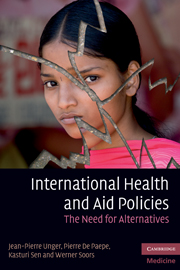Book contents
- Frontmatter
- Contents
- Preface
- Biographies
- Notices
- Acknowledgements
- List of abbreviations
- Reviews
- Introduction: Overview and purpose
- Section 1 Paradigms of international policies
- Section 2 The failure of the aid paradigm: poor disease control in developing countries
- Section 3 Impact of international health policies on access to health in middle-income countries: some experiences from Latin America
- Section 4 Determinants and implications of new liberal health policies: the case of India, China and Lebanon
- Section 5 Principles for alternative, publicly oriented health care policies, planning, management and delivery
- Section 6 A public health, strategic toolkit to implement these alternatives
- Conclusions
- Glossary
- Index
- References
Section 6 - A public health, strategic toolkit to implement these alternatives
Published online by Cambridge University Press: 06 December 2010
- Frontmatter
- Contents
- Preface
- Biographies
- Notices
- Acknowledgements
- List of abbreviations
- Reviews
- Introduction: Overview and purpose
- Section 1 Paradigms of international policies
- Section 2 The failure of the aid paradigm: poor disease control in developing countries
- Section 3 Impact of international health policies on access to health in middle-income countries: some experiences from Latin America
- Section 4 Determinants and implications of new liberal health policies: the case of India, China and Lebanon
- Section 5 Principles for alternative, publicly oriented health care policies, planning, management and delivery
- Section 6 A public health, strategic toolkit to implement these alternatives
- Conclusions
- Glossary
- Index
- References
Summary
Introduction to Section 6
Two policies conflict over the semantics of ‘access.’ For international aid agencies and Global Health Initiatives, access means ‘people's use of disease-specific interventions’ (Gwatkin et al., 2005), but for NGOs and government services acting as ‘outlets’ (Mills & Hanson, 2003) access refers to compliance in disease-control programme interventions (Hardon et al., 2009; Kumaresan et al., 2001; WHO Department of Reproductive Health and Research & United Nations Population Fund, 2003). As in the current chapter some academic institutions (Geneva University Hospitals, 2006; Olivier de Sardan & Jaffré, 2003) and NGOs (Marriott, 2009) have emphasized access to CHC (family and hospital medicine) as the core of the meaning of access.
In parallel with the principles highlighted in the previous section, strategies to improve access to good quality, comprehensive care in participatory, publicly oriented services are presented in this section. Although these strategies might appear somewhat prescriptive, they are in fact derived from professional experience that needs to be adapted in different contexts.
There is a combination of reflection and empirical evidence in this section. The first chapter advocates patient-centred care for general practitioners in LMICs where often there is no such tradition. The second chapter (Parts 1 and 2) reports field experiences in improving access to general practice in public services (in Ecuador, Chapter 18, Part 1), and access to drugs (in Senegal, Chapter 18, Part 2). We have also considered the thorny issue of the purchase of medicines by users of health services.
- Type
- Chapter
- Information
- International Health and Aid PoliciesThe Need for Alternatives, pp. 199 - 200Publisher: Cambridge University PressPrint publication year: 2010



